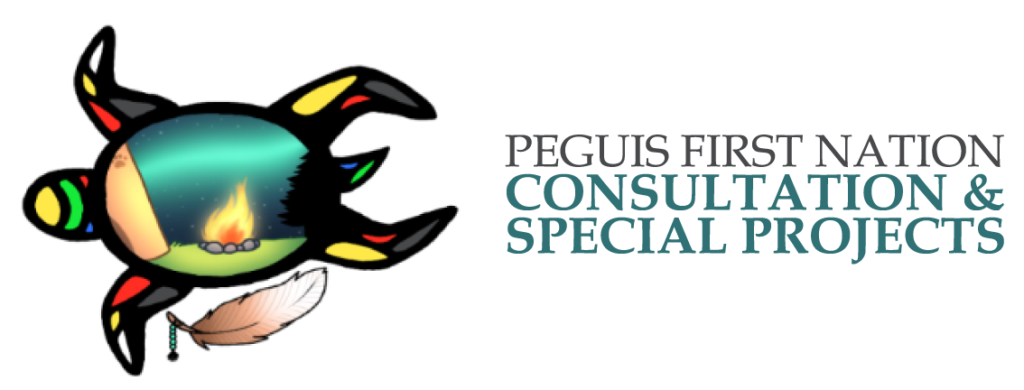Peguis Consultation and Special Projects Inc. unit was started up in 2013, by Peguis Council members to deal with Section 35 Consultation issues and engagement processes.
To many, Companies were coming into their traditional territory without consent to harvest and extract resources.
We also were not a participant in Environmental Hearings, Environmental Impact Statement (EIS) and Assessments. The EIS is a government document that outlines the impact of a proposed project on its surrounding environment. In Canada, these statements are mandated by provincial and federal law for certain projects.
By 2017 we had established a small office to deal with any and all Environmental Issues and Section 35 Consultation and Engagement Processes.
We have now grown to a staff of 14 and Professional services contractors such Hydrology, Archaeology, Biology, etc.
We have now 9 Departments within our Unit:
- Section 35 Consultation, Engagement and Accommodations
- Environmental Department
- Traditional Environmental Monitoring
- Land-Based Education
- Forestry
- Archeological & Heritage Resources Department
- Mapping & Geographic Information System (GIS)
- Community Comprehensive Planning (CCP)
- Community Development
Section 35 Consultation, Engagement and Accommodations: Our Community was never consulted on issue pertaining to our traditional lands by companies extracting our natural resources, it wasn’t until 2012 when Peguis created this unit to ensure adequate engagement processes were established. This also included Environmental Hearings at the Provincial & Federal Levels.
Environmental Department: We will be involved in Environmental assessment, and Environmental Impact Statements on Federal and Provincial projects. We also go out to do field studies and assess projects in a certain area prior to Construction and as a part of the Sec 35 engagement process.
Traditional Environmental Monitoring: We train our people to be environmental monitors who are recruited to go out on major projects to ensure the proponents are following the conditions that are set forth by the regulatory bodies during the pre-construction, Construction phase and post Construction phase. We also do all our own in-house training for our monitors in various disciplines and capacities.
Land-Based Education: We believe our responsibility with protecting our lands and waters start with our children. We are leaders in land-based education programming and have worked with many First Nation schools and communities and are now working with Provincial schools and School Divisions. Land-based is for everyone, we believe, as we all use the lands and waters so in order to protect them, we provide the educational programming to all schools and organizations that want to learn.
Forestry: One of our oldest and extensive industries was the forestry industry, about 15 years ago there was a house crash in the National housing market impacting our community’s main source of industry. We are now trying to reignite that industry and have our own quota system we are resurrecting, along with that we are also looking at all types of Sylva Culture projects and wood salvage opportunities.
Archeology & Heritage Resources Division: Many major projects in our traditional use areas would uncover ancient remains of our people and artifacts, those items uncovered during construction or field studies and surveys belong to the indigenous people of this land. We are now ensuring we have our monitors trained in this area to monitor the many major projects, and we also educate Govt and industry in the importance of ceremonial practices and protocols that are required to be done by our Elders when there are chance finds. We are working with provincial bodies and Federal Departments on establishing Chance Find Protocols and hope to establish a Federal Legislation to Protect our Heritage resources.
Mapping & Geographic Information System (GIS): Cartographic mapping will be used to track our traditional knowledge of the lands and waters. These maps can show sacred sites, the paths of moose or caribou, the best areas to find a particular species of fish, where to pick traditional medicine and much more. Maps will aid us when major projects are being proposed in our Indigenous land; they illustrate potential impacts these projects could have on the environment and the communities’ way of life.
Community Comprehensive Planning (CCP): Peguis First Nation has been working on our own CCP for some time now. With a solid CCP we can develop our own path to prosperity and ensure our Traditional, Cultural and Spiritual ways and beliefs are protected. A good CCP will be developed by the people of the community, young and old, staff and leadership.
Community Development: One of the many shortfalls our FN communities have is the lack of knowledge in accessing the Millions of dollars out there. We have in place a staff person that has great experience in finding grants and other sources of funding we can tap into. We also have in place the people to write those proposals to access the necessary funding to support our many programs and depts.
